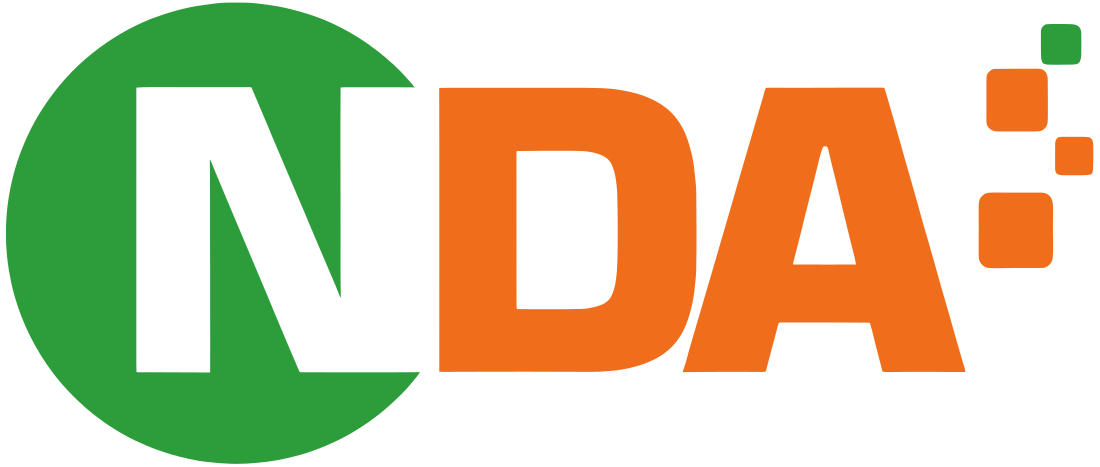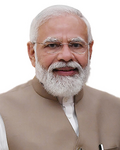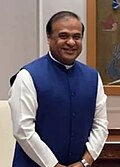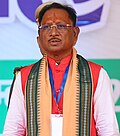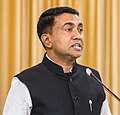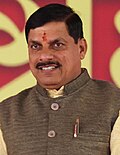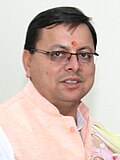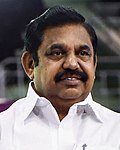Top Qs
Timeline
Chat
Perspective
National Democratic Alliance
Indian big tent political coalition led by the BJP From Wikipedia, the free encyclopedia
Remove ads
The National Democratic Alliance (NDA; ISO: Rāṣṭrīya Lokatāntrik Gaṭhabandhan) is an Indian big tent multi-party political alliance, led by the country's biggest political party, the Bharatiya Janata Party (BJP).[7] It was founded on 15 May 1998.[8] It currently has a majority in both the Lok Sabha and the Rajya Sabha, and controls the Government of India as well as the governments of 19 out of 28 Indian states and 2 out of 3 Union territories with legislative assemblies.
Its first chairman was then Prime Minister of India Atal Bihari Vajpayee. L. K. Advani, the former Deputy Prime Minister, took over as chairman in 2004 and served until 2014, and Amit Shah has been the chairman since 2014. The coalition ruled from 1998 to 2004. The alliance returned to power in the 2014 general elections with a combined vote share of 38.5%.[9] Its leader Narendra Modi was sworn in as Prime Minister of India on 26 May 2014. In the 2019 general election, the alliance further increased its tally to 353 seats with combined vote share of 45.43%.[10] The alliance lost 60 seats in the 2024 general election, but retained enough to form a coalition government, a first in over 10 years. On 7 June 2024, Modi confirmed the support of 293 MPs to Droupadi Murmu, the President of India.[11] This marked Modi's third term as Prime Minister and his first time heading a coalition government,[12] with the Telugu Desam Party of Andhra Pradesh and Janata Dal (United) of Bihar emerging as two main allies.[13][14][15]
Remove ads
History
Summarize
Perspective


The NDA was formed in May 1998 as a coalition to contest the general elections. The main aim of the NDA was to form an anti-Indian National Congress coalition. It was led by the BJP, and included several regional parties, including the Samata Party and the AIADMK, as well as Shiv Sena, but Shiv Sena broke away from the alliance in 2019 to join the Maha Vikas Aghadi with Congress and the NCP. Samata Party also broke away from alliance in 2003 after formation of Janta Dal (United). The Shiv Sena was the only member which shared the Hindutva ideology of the BJP.[16][17] After the election, it was able to muster a slim majority with outside support from the Telugu Desam Party, allowing Atal Bihari Vajpayee to return as prime minister.[18]
The government collapsed within a year because the AIADMK withdrew its support. After the entry of a few more regional parties, the NDA proceeded to win the 1999 elections with a larger majority. Vajpayee became Prime Minister for a third time, and this time served a full five-year term.[19]
The NDA called elections in early 2004, six months ahead of schedule. Its campaign was based around the slogan of "India Shining" which attempted to depict the NDA government as responsible for a rapid economic transformation of the country. However, the NDA suffered a defeat, winning only a 186 seats in the Lok Sabha, compared to the 222 of the United Progressive Alliance led by the Congress, with Manmohan Singh succeeding Vajpayee as prime minister. Commentators have argued that the NDA's defeat was due to a failure to reach out to the rural masses.[20][21] The scenario however changed quickly with the rise of Gujarat CM Narendra Modi who went on to become India's PM from 2014 onwards.
Remove ads
Structure
Summarize
Perspective
The National Democratic Alliance does not have a formal governing structure such as an executive board or politburo. It has been up to the leaders of the individual parties to make decisions on issues such as sharing of seats in elections, allocation of ministries and the issues that are raised in Parliament. Given the varied ideologies among the parties, there have been many cases of disagreement and split voting among the allies.
Owing to ill health, George Fernandes, who was the NDA convener until 2008, was discharged of his responsibility and replaced by Sharad Yadav, the then national president of the JD(U) political party. On 16 June 2013, the JD(U) left the coalition and Sharad Yadav resigned from the role of the NDA convener. Then the Chief Minister of Andhra Pradesh N. Chandrababu Naidu was made the NDA convener.[22] Later in 2018, after the withdrawal of TDP from NDA the post of convenor was vacant. However NDA allies like LJP demanded the appointment of a convenor in 2019 for better coordination of the allies.[23]
On 27 July 2017 JD(U) with the help of BJP formed the government in Bihar. Later, on 19 August 2017 JD(U) formally rejoined the NDA after 4 years.[24]
List of chairmans
- Atal Bihari Vajpayee - 1998 to 2004
- L. K. Advani - 2004 to 2014
- Amit Shah - 2014 to Till date
List of convenors
- George Fernandes - 1998 to 2008
- Sharad Yadav - 2008 to 2013
- N. Chandrababu Naidu - 2013 to 2018
Remove ads
Strength in parliament
State/UT wise MPS
Remove ads
Governments
Summarize
Perspective
The BJP has previously been the sole party in power in Jharkhand. It has also ruled Jammu and Kashmir, Punjab as part of coalition and alliance governments.
The NDA has never been in power in 3 states – Kerala, Telangana (between 1999 and 2004 BJP in alliance with TDP ruled a United Andhra Pradesh), and West Bengal. But BJP led NDA has ruled many local governing institutions including corporations, municipalities, panchayats and has also been elected to many Lok Sabha constituencies, state assembly constituencies and local body divisions and wards in these 3 states.
List of current NDA governments

Remove ads
Strength in legislative assemblies
Summarize
Perspective
The following is a list of the current number of Members of Legislative Assembly (MLAs) from the BJP as well as other political parties in the NDA in each of the 28 Indian states and 3 Union territories with legislative assemblies. The NDA currently holds a majority of the seats in 19 states and two Union territories, out of which the BJP on its own holds a majority of the seats in 13 states and one Union territory.
Remove ads
List of presidents and vice presidents
Summarize
Perspective
Note that it refers to nomination by alliance, as the offices of President and Vice President are apolitical.
Presidents
Vice presidents
Remove ads
List of prime ministers
List of deputy prime ministers
Remove ads
List of chief ministers

Remove ads
List of deputy chief ministers
Member parties
Summarize
Perspective
As of March 2025, there are 39 political parties that are members of the alliance. The Bharatiya Janata Party and the National People's Party are the only two political parties being recognised by the Election Commission of India as national parties.[34] Other parties in the alliance are either recognised as state level parties or unrecognised parties.
Remove ads
Candidates in elections
Lok Sabha general elections
Remove ads
Electoral history
Summarize
Perspective
Lok Sabha 1998 general election
Lok Sabha 1999 general election
Lok Sabha 2004 general election
Lok Sabha 2009 general election
Lok Sabha 2014 general election
Contested on BJP symbol lotus
Lok Sabha 2019 general election
Contested on AIADMK two leaves symbol
Lok Sabha 2024 general election
Contested by BJP symbol lotus
- Indhiya Jananayaga Katchi
- Puthiya Needhi Katchi
- Tamizhaga Makkal Munnetra Kazhagam
- Inthiya Makkal Kalvi Munnetra Kazhagam
Electoral performance
Timeline
Summarize
Perspective
1999
- The Telugu Desam Party extended outside support to the NDA, allowing Atal Bihari Vajpayee to become the first BJP Prime Minister.[35][36]
2004
- Telugu Desam Party withdrew from the NDA.[37]
2009
- The Telangana Rashtra Samithi in United Andhra Pradesh, joined the NDA on 10 May 2009[38][39] and subsequently denied the fact that it joined NDA and clarified that they only extended the support.[40]
- Indian National Lok Dal in Haryana, joined the NDA on 19 September 2009,[41] but later withdrawed it.
2011
- Kuldeep Bishnoi led Haryana Janhit Congress (BL) Joined NDA.
- Ramdas Athawale led Republican Party of India (A) Joined NDA.
- Ajit Singh led Rashtriya Lok Dal withdrawn from the NDA.
2012
- Presidential election
- NDA nominated P. A. Sangma as its presidential candidate who lost against UPA's Pranab Mukherjee.
- Vice-Presidential election
- Jaswant Singh was named as the candidate for the post of Vice-President against UPA's Hamid Ansari. Ansari won his second term in office.[42]
2013
- On 16 June 2013, Nitish Kumar led Janta Dal United has withdrawn from NDA.
- On 13 September 2013, Narendra Modi declared as PM candidate for 2014 Elections.
2014
- On 1 January 2014, Marumalarchi Dravida Munnetra Kazhhagam leader Vaiko has announced that MDMK formally joined back to NDA.
- The two small parties viz Kongunadu Munnetra Kazhagam and Indhiya Jananayaga Katchi have also joined NDA.
- The BJP would like two more southern parties such as Desiya Murpokku Dravida Kazhagam, Pattali Makkal Katchi to also join the alliance.[43]
- In Maharashtra, two regional political outfits, Swabhimani Paksha and Rashtriya Samaj Paksha, joined NDA in January.[44]
- The coalition of five parties is termed as Mahāyuti (Marathi: महायुति, lit. 'Grand Alliance'). So in Maharashtra now NDA alliance consist of 5 Parties viz BJP, Shiv Sena, Republican Party of India, Swabhimani Paksha and Rashtriya Samaj Paksha.[45]
- On 23 February 2014, Rashtriya Lok Samata Party led by Upendra Kushwaha joined NDA and will be contesting at 3 Lok Sabha seats in Bihar.[46]
- On 27 February 2014 Lok Janshakti Party led by Ram Vilas Paswan joined NDA[47] It would contest at 7 Lok Sabha Seats in Bihar during 2014 Elections.[48]
- DMDK will be fighting Lok Sabha Election through an alliance with BJP led NDA.[49]
- Pattali Makkal Katchi led Social Democratic Alliance are the other allies of NDA in Tamil Nadu.
- Maharashtra Navnirman Sena : Its President, Raj Thackeray announced external support to NDA on 9 March 2014 which is marked as Party's formation day, supporting Narendra Modi as Prime Ministerial Candidate.
- Indian National Lok Dal : Its Gen. Sec., Sh. Ajay Singh Chautala announced external support to NDA, supporting Sh. Narendra Modi as Prime Ministerial Candidate.
- Lok Satta Party : President Shri J P Narayan announced external support to NDA, supporting Sh. Narendra Modi as Prime Ministerial Candidate
- All India NR Congress (AINRC) formally joined NDA on 13 March 2014 and will be contesting in Puducherry.[50]
- On 6 April 2014, Telugu Desam Party rejoined the NDA after breaking the alliance in 2004 following the general election defeat.[51]
- Shiv Sena Though Shiv Sena has quit Mahayuti in Maharashtra, before Maharashtra Legislative Assembly Elections 2014, but has decided to remain with NDA at the centre.[52]
- All Jharkhand Students Union clinched an alliance with BJP for Jharkhand Assembly elections under which its junior partner will contest eight of the 81 seats in the state.[53]
2015
- Bharatiya Janata Party on 27 February 2015 clinched an alliance with People's Democratic Party for Government Formation in Jammu and Kashmir under which its CM will be from PDP.[54]
- In the month of November, BJP alliance lost the legislative assembly election in Bihar to the Mahagathbandhan comprising JD(U), RJD and the INC.
2016
- In January 2016, Bharatiya Janata Party clinched an alliance with Bodoland People's Front in Assam.[55]
- In March 2016, after a meeting with AGP President Atul Bora and former Chief Minister Prafulla Kumar Mahanta, BJP formed an alliance with Asom Gana Parishad for upcoming Assam legislative assembly election 2016.[56]
- BJP also aligned with Rabha and Tiwa Tribe outfit Rabha Jatiya Aikya Manch and Tiwa Jatiya Aikya Manch.
- In March 2016, BJP forged an alliance with Kerala-based Ezhava outfit Bharath Dharma Jana Sena Party for Kerala Elections 2016.[57]
- Following BJP's victory in the Assam Legislative Assembly Elections 2016, the party formed an alliance of like-minded non-Congress parties in the Northeast, called the North-East Democratic Alliance, consisting of 11 regional parties of Northeast India.
- Himanta Biswa Sarma, BJP leader from Assam has been appointed Convener of the regional alliance.
- On 21 December 2016, Khandu was suspended from the party by the party president and Takam Pario was named as the next likely Chief Minister of Arunachal Pradesh replacing Khandu after People's Party of Arunachal suspended Khandu along with 6 other MLAs.[58][59][60]
- In December 2016, Khandu proved majority on the floor of the legislative assembly with 33 of the People's Party of Arunachal's 43 legislators joining the Bharatiya Janata Party as the BJP increased its strength to 45 and had the support of two independents. He became second Chief Minister of Arunachal Pradesh of Bharatiya Janata Party in Arunachal Pradesh after the 44 days lead Gegong Apang government in 2003.[61][62]
2017
- In January 2017, Bharatiya Janata Party's alliance partner Maharashtrawadi Gomantak Party in Goa and Shiv Sena in Maharashtra came together to contest Goa Legislative Assembly election in 2017 against the BJP with another Sangh Pariwar group called Goa Suraksha Manch.[63]
- The results of the 2017 Goa Assembly election gave rise to a hung assembly since no political party could achieve a complete majority of 21 in the 40 member Goa Legislative Assembly.
- The Indian National Congress emerged the largest party with 17 seats but ultimately, the Bharatiya Janata Party which emerged victorious in 13 constituencies formed the government with the support of the Goa Forward Party, Maharashtrawadi Gomantak Party and independents.[64]
- The Goa Forward Party expressed its support to the Bharatiya Janata Party on the condition that the then Union Defence Minister of India Manohar Parrikar would return to Goa as the Chief Minister of Goa.[65]
- On 15 March 2017, N. Biren Singh was sworn as the Chief Minister by having coalition with NPP, NPF, LJP and others, the first time that BJP formed a government in Manipur, though the INC emerged as the single largest party.
- On 27 July 2017, Janata Dal (United) rejoined NDA and formed a coalition government with Bharatiya Janata Party (BJP) in Bihar with Nitish Kumar as the Chief Minister and Sushil Kumar Modi as the Deputy Chief Minister, and with that BJP completed its domination in Hindi belt.[66]
2018
- On 9 March 2018, Biplab Kumar Deb was sworn as the Chief Minister having a pre-poll alliance with IPFT, the first time that BJP formed a government in Tripura.
- On 16 March 2018, Telugu Desam Party withdrew from the NDA citing the BJP's failure to fulfill the promises made in the State Reorganisation Act and to grant special status to Andhra Pradesh.[67][68][69]
- Rashtriya Lok Samata Party (RLSP) withdrew from the NDA on 10 December 2018, citing a lack of progress on development in Bihar.[70]
- In December 2018's state elections, the NDA lost elections in Madhya Pradesh, Rajasthan, and Chhattisgarh to the INC. In Chhattisgarh, BJP was defeated by the INC with 3/4th majority. It was also defeated by the TRS in Telangana and BJP managed to win only 1 seat out of the 119 constituencies in Telangana
2019
- On 7 January 2019, the AGP withdrew from the NDA and also from the Assam Government on the issue of citizenship amendment bill.
- On 21 January 2019, the GJM withdrew from the NDA and extended the support to Mamata Banerjee .
- On 19 February 2019, AIADMK and PMK rejoined NDA and BJP announced that "They will contest 5 Lok sabha seats in Tamil Nadu".
- On 19 February 2019, Pattali Makkal Katchi rejoined NDA
- BJP announced that "They will contest 5 Lok sabha seats in Tamil Nadu".
- On 10 March 2019, DMDK rejoined NDA.
- On 8 March 2019 in Sikkim, BJP joined hands with opposition party SKM
- On 12 March 2019 in Assam, BJP joined hands with old ally AGP[71]
- On 12 March 2019 in Maharashtra, Rayat Kranti Sanghatana is a part of NDA[72]
- On 25 March 2019 in Tamil Nadu, Puthiya Needhi Katchi is a part of Alliance[73]
- On 4 April 2019 in Rajasthan, BJP joined hands with the RLP[74]
- On 5 April 2019 in Uttar Pradesh, Nishad Party joined hands with NDA[75]
- On 23 May 2019 NDA won the 2019 Indian General election with record breaking 352 seats with its allys
- In May 2019, NDA lost state elections of Andhra Pradesh & Odisha
- In May 2019, NDA won the state elections of Arunachal Pradesh & Sikkim.
- On 25 October 2019 in Haryana,
JJP joined hands with NDA to forming a stable government at Haryana with BJP[76]
- On 11 November 2019 in Maharashtra,
Shiv Sena exited from the NDA, as BJP was not willing to agree for Sharing CM Post with Shiv Sena to form government in Maharashtra.[77]
- In November 2019, NDA won the state election of Haryana
- In November 2019, NDA lost the state election of Maharashtra
- On 15 November 2019 in Jharkhand,
BJP, AJSU sever ties in Jharkhand days before Assembly elections 2019.[78]
- On 23 November 2019 in Maharashtra, NCP (Ajit Pawar Faction) joined NDA, Ajit Pawar took oath as Maharashtra's Deputy Chief Minister.
- On 26 November 2019 in Maharashtra, Ajit Pawar resigns as Maharashtra's Deputy Chief Minister. With immediate effect Devendra Fadnvis also resigns from the post of CM of Maharashtra. His term becomes the shortest term as Maharashtra's Chief Minister.
- In December 2019, NDA lost the state election of Jharkhand.
2020
- On 16 January 2020 Jana Sena of Pawan Kalyan announced that tying up with Bharatiya Janata Party in Andhra Pradesh, this decision came after Chief minister Y. S. Jagan Mohan Reddy's intention to decentralise the capital, instead of developing Amaravati.[79][80][81]
- Jharkhand Vikas Morcha (Prajatantrik) led by Babulal Marandi merged with the Bharatiya Janata Party on 17 February 2020, at Jagannathpur Maidan, Ranchi in presence of Union Home Minister Amit Shah, BJP president Jagat Prakash Nadda and former Chief Ministers of Jharkhand Arjun Munda and Raghubar Das.[82][83][84][excessive citations] Earlier, Marandi expelled MLAs Pradeep Yadav and Bandhu Tirkey from the party for "anti-party activities".[85] Both of them later joined Indian National Congress in its Delhi headquarters.[86]
- In February 2020, NDA lost the state election of Delhi
- In August 2020, Hindustani Awam Morcha re-joined NDA & granted 7 seats to contest in 2020 Bihar Legislative Assembly election.
- Shiromani Akali Dal announced leaving NDA in September 2020.
- In October 2020, the Vikassheel Insaan Party which had left the Mahagathbandhan (Bihar) joined the National Democratic Alliance and was granted 11 seats to contest.
- In October 2020, The All Jharkhand Students Union re-joined NDA.
- In October 2020, Gorkha Janmukti Morcha broke the alliance ahead of 2021 West Bengal Legislative Assembly election and allied with All India Trinamool Congress.[87]
- In October 2020, Kerala Congress (Thomas) broke the alliance ahead of 2021 Kerala Legislative Assembly election and allied with United Democratic Front.[88]
- In November 2020, BJP had the alliance with Bodoland People's Front ahead of 2020 Bodoland Territorial Council election.[89][irrelevant citation]
- In November 2020, NDA won the state election of Bihar.
- In December 2020, United People's Party Liberal and Gana Suraksha Party joined the NDA and NEDA as alliance to Executive Committee in Bodoland Territorial Council.[90][91]
- In December 2020, Rashtriya Loktantrik Party broken the alliance on the issue of 3 agriculture reforms laws.[92]
2021
- In March 2021, Kerala Congress (Thomas) Has Withdrawn alliance ahead of 2021 Kerala Legislative Assembly election And Joined United Democratic Front.[93]
- In March 2021, Desiya Murpokku Dravida Kazhagam broken the alliance for not issuing demanded number of constituency in the 2021 Tamil Nadu Legislative Assembly election.[94]
- In April 2021, Goa Forward Party withdrew from the NDA for a variety of reasons, ranging from environmental issues to BJP apathy towards unemployment.[95]
- In May 2021, NDA lost state elections of Tamil Nadu, Kerala, West Bengal
- In May 2021, NDA won state elections of Assam & Puducherry.
- In May 2021, Sukhdev Singh Dhindsa led Shiromani Akali Dal (Sanyukt) joined NDA.
- In December 2021, Captain Amrinder Singh led Punjab Lok Congress joined NDA.
2022
- In January 2022, Simarjit Singh Bains led Lok Insaaf Party joined NDA.
- In January 2022, Simarjit Singh Bains led Lok Insaaf Party broken the alliance for not issuing demanded number of constituency in the 2022 Punjab Legislative Assembly election.
- Bodoland People's Front rejoined NDA.
- NDA won the state elections of Uttar Pradesh, Goa, Uttarakhand & Manipur.
- NDA lost the state elections of Punjab.
- In June 2022 Shivsena leader Eknath Shinde along with rebel MLAs joined NDA and formed a government on 30 June 2022 with Shinde as Chief Minister of Maharashtra and BJP leader Devendra Fadnavis as Deputy Chief Minister of Maharashtra .
- After Goa Assembly elections 2022 Maharashtrawadi Gomantak Party extended support to NDA.
- On 9 August 2022, Nitish Kumar led Janata Dal (United) has withdrawn from NDA.[96]
- On 19 September, Capt. Amrinder Singh led Punjab Lok Congress merged with BJP[97]
- NDA won state elections of Gujarat.
- NDA lost the state elections of Himachal Pradesh.
2023
- In February, BJP broke alliance with National People's Party to contest all seats in 2023 Meghalaya Legislative Assembly election[98]
- NDA won state elections in Tripura, Meghalaya and Nagaland.
- NDA lost state election in Karnataka.
- In June 2023 Hindustani Awam Morcha Joined NDA
- In July 2023 MLAs from NCP led by Ajit Pawar joined NDA and Ajit Pawar took oath as the Deputy Chief Minister of Maharashtra
- In July 2023 Suheldev Bharatiya Samaj Party Joined NDA
- In September 2023, Janata Dal (Secular) joined NDA[99]
- On 25 September 2023, AIADMK left the NDA alliance.[100][101][102]
- In December 2023, NDA made a record breaking victory in the decisive states of Chhattisgarh, Madhya Pradesh and Rajasthan, routing the incumbent Congress. The NDA lost in Telangana.
2024
- On 28 January 2024, Nitish Kumar led Janata Dal (United) rejoined NDA by quitting Mahagathbandhan and I.N.D.I.A. Alliance. It formed a coalition government with Bharatiya Janata Party (BJP) in Bihar with Nitish Kumar as the Chief Minister and two Deputy Chief Ministers from BJP.[103]
- On 8 February 2024, Nationalist Congress Party officially enters the alliance after Election Commission of India recognitions it to be the legitimate party over the Sharad Pawar led faction.[104]
- On 9 February 2024, Rashtriya Lok Dal led by Jayant Singh entered the alliance after securing deal of two Lok Sabha seats in Uttar Pradesh with BJP.[105]
- On 7 March 2024, Tipra Motha Party joined NDA and two ministers sworn in Tripura Government.[106]
- On 9 March 2024, TDP rejoined the NDA,[107] forming a three-party coalition colloquially referred to in Telugu as Kūṭami (Telugu: కూటమి, lit. 'Alliance')[108] comprising the BJP, Janasena Party and Telugu Desam Party. As part of the arrangement, the TDP and Janasena contested 17 and 2 seats, respectively in the general elections, and 144 and 21 seats, respectively in the Andhra Pradesh state legislative assembly elections.[109]
- On 4 June, NDA made a record breaking victory in the 2024 Indian general election as the alliance recorded its third consecutive victory. NDA also made a record breaking victory in the decisive states of Andhra Pradesh, Arunachal Pradesh, Sikkim and Odisha, where it defeated the incubment BJD government, which was in power for the last 24 years.
- In October 2024, NDA made a record breaking victory in the decisive state of Haryana, routing the Congress. The NDA lost in Jammu and Kashmir, though it managed to increase its seats and garner the most votes. It did particularly well in Jammu region.
- In November 2024, NDA made a record breaking landslide victory in the decisive state of Maharashtra, routing the Congress led alliance. The NDA lost in Jharkhand.
2025
- In February 2025, BJP wins election of NCT Delhi assembly and comes power after 27 years.
- On 11 April 2025, AIADMK General Secretary Edappadi K. Palaniswami and BJP leader and Home Minister Amit Shah announced their alliance for 2026 Tamil Nadu Assembly election on a Joint Press Conference at Chennai,thus AIADMK rejoining NDA.[110][111]
See also
Notes
References
External links
Wikiwand - on
Seamless Wikipedia browsing. On steroids.
Remove ads
